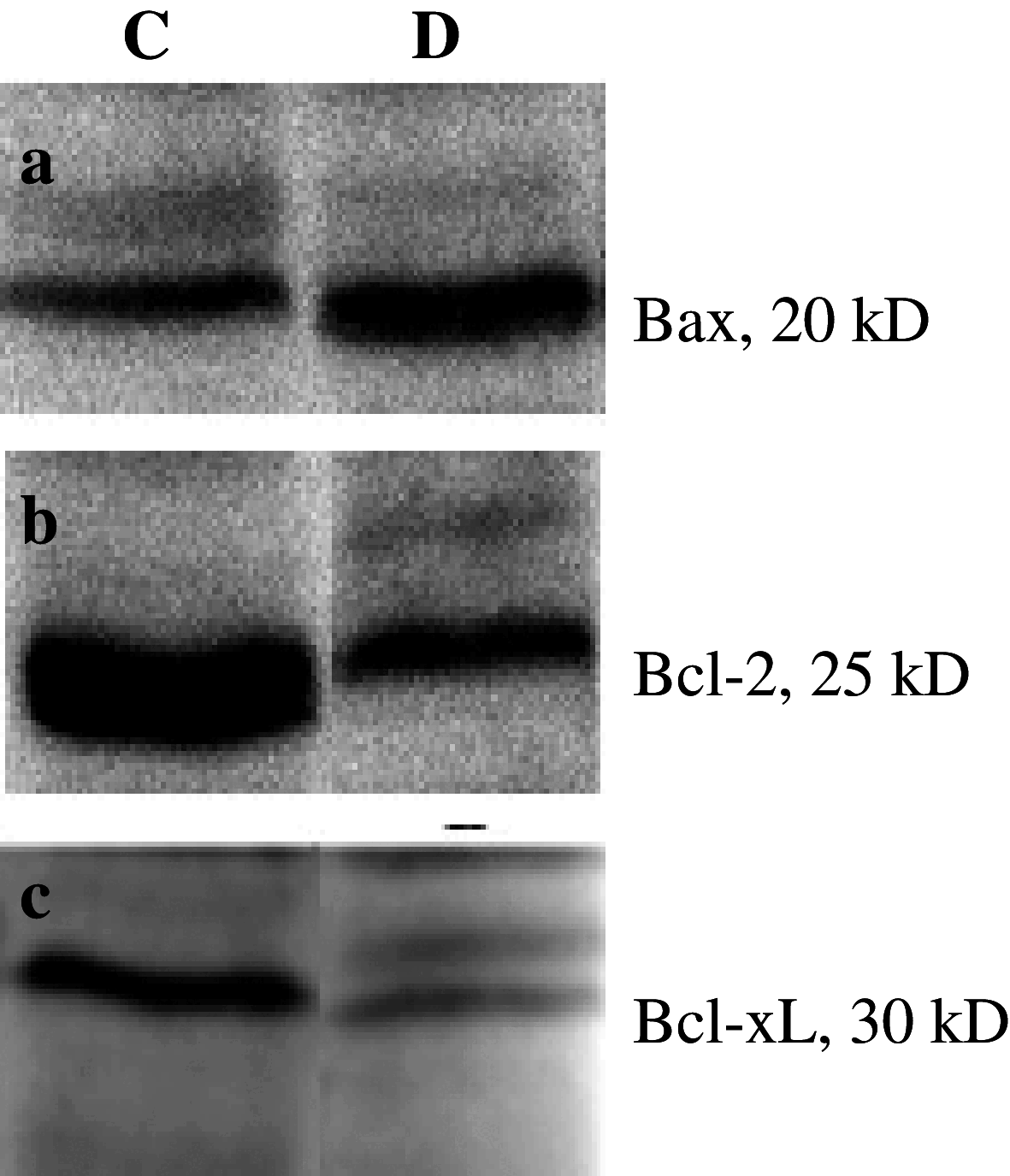Evaluation of insulin and ascorbic acid effects on expression of Bcl-2 family proteins and caspase-3 activity in hippocampus of STZ-induced diabetic rats
- PMID: 18758938
- PMCID: PMC11505789
- DOI: 10.1007/s10571-008-9305-y
Evaluation of insulin and ascorbic acid effects on expression of Bcl-2 family proteins and caspase-3 activity in hippocampus of STZ-induced diabetic rats
Abstract
Aims: Effects of insulin and ascorbic acid on expression of Bcl-2 family proteins and caspase-3 activity in hippocampus of diabetic rats were evaluated in this study.
Methods: Diabetes was induced in Wistar male rats by streptozotocin (STZ). Six weeks after verification of diabetes, the animals were treated for 2 weeks with insulin or/and ascorbic acid in separate groups. Hippocampi of rats were removed and evaluation of Bcl-2, Bcl-x(L), and Bax proteins expression in frozen hippocampi tissues were done by SDS-PAGE electrophoresis and blotting. The Bcl-2, Bcl-x(L), and Bax proteins bands were visualized after incubation with specific antibodies using enhanced chemiluminescences method. Caspase-3 activity was determined using the caspase-3/CPP32 Fluorometric Assay Kit.
Results: Diabetic rats showed increase in Bax protein expression and decrease in Bcl-2 and Bcl-x(L) proteins expression. The Bax/Bcl-2 and Bax/Bcl-x(L) ratios were found higher compared with non-diabetic control group. Treatments with insulin and/or ascorbic acid were resulted in decrease in Bax protein expression and increase in Bcl-2 and Bcl-x(L) proteins expression. The Bcl-2/Bax and Bcl-x(L)/Bax ratios were found higher in treated groups than untreated diabetic group. Caspase-3 activity level was found higher in diabetic group compared with non-diabetic group. Treatment with insulin and ascorbic acid did downregulated caspase-3 activity.
Conclusions: Our data provide supportive evidence to demonstrate the antiapoptotic effects of insulin and ascorbic acid on hippocampus of STZ-induced diabetic rats.
Figures






Similar articles
-
The Effects of Lycopene and Insulin on Histological Changes and the Expression Level of Bcl-2 Family Genes in the Hippocampus of Streptozotocin-Induced Diabetic Rats.J Diabetes Res. 2017;2017:4650939. doi: 10.1155/2017/4650939. Epub 2017 Jun 1. J Diabetes Res. 2017. PMID: 28656152 Free PMC article.
-
Evaluation of Bcl-2 family gene expression and Caspase-3 activity in hippocampus STZ-induced diabetic rats.Exp Diabetes Res. 2008;2008:638467. doi: 10.1155/2008/638467. Epub 2008 Oct 12. Exp Diabetes Res. 2008. PMID: 18923682 Free PMC article.
-
[Effect of electroacupuncture combined with Zhuang-medicine-thread moxibustion on expression of apoptosis-related factors in gastric antrum of diabetic gastroparesis rats].Zhen Ci Yan Jiu. 2022 Sep 25;47(9):801-8. doi: 10.13702/j.1000-0607.20220268. Zhen Ci Yan Jiu. 2022. PMID: 36153455 Chinese.
-
Chitosan-stabilized selenium nanoparticles alleviate cardio-hepatic damage in type 2 diabetes mellitus model via regulation of caspase, Bax/Bcl-2, and Fas/FasL-pathway.Gene. 2021 Feb 5;768:145288. doi: 10.1016/j.gene.2020.145288. Epub 2020 Nov 10. Gene. 2021. PMID: 33181259
-
Aminoguanidine changes hippocampal expression of apoptosis-related genes, improves passive avoidance learning and memory in streptozotocin-induced diabetic rats.Cell Mol Neurobiol. 2014 Apr;34(3):343-50. doi: 10.1007/s10571-013-0018-5. Epub 2013 Dec 11. Cell Mol Neurobiol. 2014. PMID: 24326522 Free PMC article.
Cited by
-
Mechanisms of action of brain insulin against neurodegenerative diseases.J Neural Transm (Vienna). 2014 Jun;121(6):611-26. doi: 10.1007/s00702-013-1147-1. Epub 2014 Jan 9. J Neural Transm (Vienna). 2014. PMID: 24398779 Review.
-
The protective effects of insulin and natural honey against hippocampal cell death in streptozotocin-induced diabetic rats.J Diabetes Res. 2014;2014:491571. doi: 10.1155/2014/491571. Epub 2014 Mar 13. J Diabetes Res. 2014. PMID: 24745031 Free PMC article.
-
The study of apoptotic bifunctional effects in relationship between host and parasite in cystic echinococcosis: a new approach to suppression and survival of hydatid cyst.Parasitol Res. 2012 May;110(5):1979-84. doi: 10.1007/s00436-011-2726-4. Epub 2011 Dec 14. Parasitol Res. 2012. PMID: 22167369
-
Apoptosis of human lymphocytes after exposure to hydatid fluid.Iran J Parasitol. 2011 Jun;6(2):9-16. Iran J Parasitol. 2011. PMID: 22347282 Free PMC article.
-
The Effects of Lycopene and Insulin on Histological Changes and the Expression Level of Bcl-2 Family Genes in the Hippocampus of Streptozotocin-Induced Diabetic Rats.J Diabetes Res. 2017;2017:4650939. doi: 10.1155/2017/4650939. Epub 2017 Jun 1. J Diabetes Res. 2017. PMID: 28656152 Free PMC article.
References
-
- Ahn YH, Kim YH, Hong SH, Koh JY (1998) Depletion of intracellular zinc induces protein synthesis-dependent neuronal apoptosis in mouse cortical culture. Exp Neurol 154:47–56. doi:10.1006/exnr.1998.6931 - PubMed
-
- Allen DA, Yaqoob MM, Harwood SM (2005) Mechanisms of high glucose-induced apoptosis and its relationship to diabetic complications. J Nutr Biochem 16:705–713. doi:10.1016/j.jnutbio.2005.06.007 - PubMed
-
- Aragno M, Mastrocola R, Brignardello E, Catalano M, Robino G, Manti R, Parola M, Danni O, Boccuzzi G (2002) Dehydroepiandrosterone modulates nuclear factor-kappaB activation in hippocampus of diabetic rats. Endocrinology 143:3250–3258. doi:10.1210/en.2002-220182 - PubMed
-
- Ashkenazi A, Dixit VM (1998) Death receptors: signaling and modulation. Science 281:1305–1308. doi:10.1126/science.281.5381.1305 - PubMed
-
- Bar-Am O, Weinreb O, Amit T, Youdim MB (2005) Regulation of Bcl-2 family proteins, neurotrophic factors, and APP processing in the neurorescue activity of propargylamine. FASEB J 19:1899–1901 - PubMed
Publication types
MeSH terms
Substances
LinkOut - more resources
Full Text Sources
Medical
Molecular Biology Databases
Research Materials

